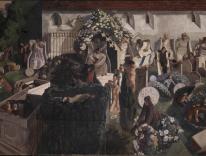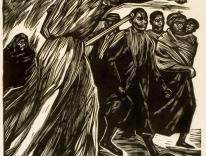
Fr. Hector Madrigal is the pastor of St. Joseph’s Catholic Church in Amarillo, Texas, which has been featured in a USCCB study on best practices for shared parishes. For nearly two decades he has served as a trainer, facilitator, and speaker on building greater appreciation of culture in church settings. From 2013 to 2016, he was a consultant to the USCCB subcommittee for Hispanic/Latino Affairs, which developed the process for the V National Encuentro of Hispanic/ Latino Ministry, and since 2014, he has been a consultant to the National Leadership Roundtable. Commonweal editor Dominic Preziosi and audience development director Milton Javier Bravo spoke with him recently about “ecclesial integration”; the importance of welcoming, accompanying, and empowering different cultural groups; and how Hispanic ministry contributes to the good of the entire Catholic Church.
Commonweal: As the pastor of St. Joseph’s, you’ve spoken of wanting to increase the appreciation of all the cultures within the Amarillo diocese and develop a stronger sense of community among all of us. Can you talk about the variety of the cultures you see, not only in the diocese but at your parish specifically?
Fr. Hector Madrigal: I’ve been at St. Joseph’s for thirteen years, and it didn’t start off with all these different groups. We had a strong group that I would call Americans; sometimes, in this part of the country, we call them white people. But we also had a significant number of what I call “integrated-slash-assimilated” Mexican Americans. Now, thirteen years later, the parish consists not only of Americans and integrated Mexican Americans, but we have many Mexican immigrants, and they’re the largest group. We also have a significant number of families from South Sudan. We have Salvadorians, Bosnian refugees, and of course, Filipinos. And that’s very much reflective of our diocese.
In terms of “appreciation,” we’ve been very clear that we’re called to open the doors of our church and our hearts to all the people who come to St. Joseph’s. And so in order to do that—partly because of my background in sociology, and partly because I understand, being a Mexican American myself—I began to preach and teach about the importance of recognizing that culture is a gift, that our cultures all have something to contribute to the church. God has brought them into our midst, to our parish. And so we are to receive them as we receive Christ, including their ways of thinking and singing and eating and praying.
CW: What kinds of successes have you seen in terms of realizing this sense of communion in your parish? And what are some of the challenges or difficulties or surprises?
HM: At the very beginning in our parish, we went through a listening process, a planning process, and we very clearly felt called as part of our mission to welcome all God’s children. We didn’t fully understand what it meant at the time. But now I tell the community it was a very prophetic experience—because within two or three months of this whole planning process, we had several South Sudanese families literally come knocking on the door, saying we’re looking for a church. And so we began with this refugee community, and it was so surprising to me how the parish just embraced the community, embraced the South Sudanese in every way they could to help them feel at home in the church.
Now the challenge, which is sad, is that about two years later, the pastoral council came to me and said, “Father, it looks like we have a lot of Spanish-speaking people in our neighborhood. Why aren’t they in our parish? Why aren’t we having Mass?” So I went through a listening process with them and then we agreed to start a Spanish Mass. That was a challenge, because the assumption is that refugees are here legally, and the majority are. But people assume that Spanish-speaking people are here illegally or are undocumented. So we had to work through all of that and begin to challenge the community that we’re here to evangelize, not to Americanize.
Now there’s another serious issue that nationally, in our episcopal region, and in our parish, we have to do a lot of work on: in bringing in the new people, we haven’t done a good job of preparing what we could call the “host” community. And so I began to accompany and listen to a lot of the people who were uncomfortable with the changes, who might even have been angry. You know, there’s a sense of loss. There’s pain in making room for the new people. You know, they’re uncomfortable with a different language, a different culture. And so I have to learn to be intentional in creating space, so they can be honest about what they feel and so we begin to understand them as well. On both sides, it’s a challenge. I call it the “heart work.” T, not D. Yes, it’s also hard work, but it’s about the heart on both sides. And the bottom line is to not be afraid of it. Diversity is a gift. The only thing that we really should be afraid of and uncomfortable with is sin and the consequences of our sin.
CW: At St. Joseph’s you have an event called “Intercultural Disciple-Making Sunday.” Is this a regular effort or something relatively new, and what is the goal of it?
HM: We’ve had it for over six years, and we try to understand what it means for us to be disciples, make disciples. I discovered that when you focus on that sense of mission, who we are as church, that makes it a lot easier. We had some difficulties throughout the years in trying to have, for example, a trilingual Christmas midnight Mass, or a trilingual Holy Saturday celebration, or to teach people at the English Mass to sing a bilingual hymn… But in focusing on how all of us are called disciples, it occurred to us, this is a wonderful opportunity for us to come together as church—not as the 10 o’clock Mass group, or the 12 noon Mass group, but together as one parish to learn what it means to be a disciple of Christ. So we separate in language groups to be able to do the catechesis. And then we come together to pray and give testimony, and then the final blessing. And then we have a reception and, you know, food brings us together—it doesn’t matter what food it is. So there are the different language groups, and the children running around, and we’re all together and just having a good time.
CW: Your parish has been identified by the United States Conference of Catholic Bishops as having achieved “a high level of ecclesial integration.” How is that determined? And what do you consider to be a high level of ecclesial integration?
HM: When I began to see that people across the board are not only supporting the parish in their own particular way, but they feel comfortable coming to the table and influencing decisions that are being made, that’s when I think that community is fully integrated.
So when you have, in our case, the three main groups—the South Sudanese, the Mexican immigrants, and the Euro-American-slash-Mexican-American—all sitting together on the financial council and the pastoral council, the two most influential bodies in the parish, they then get that place at the table to say, “Look, this is what’s going on with us.” And then they’re able to challenge each other, like, you know: “Why aren’t you coming to this event?” or “What does this word mean?” or “What is this, this ‘altar for the dead’?” And so they also kind of catechize each other, together.
[The USCCB study] began with the general understanding of what a shared parish is: one pastor serving several groups of people, people of different language groups, of different cultures. Somehow you’re having to negotiate working with each group and sharing the space in the process. So the USCCB identified twenty pastors doing this work, and began to see some things that we had in common.
The USCCB identifies nine steps to integration. There are three that I call giant steps. The first step is about welcoming, giving people a place to feel and call their home. The second, once they’ve been welcomed, is to let people feel they belong and can influence decisions. This leads to the third giant step, the commitment to stewardship and communion. There are also individual steps in between. So the USCCB looked at the twenty parishes they studied and were able to find evidence of all nine steps at St. Joseph.
[25 percent of U.S. parishes intentionally serve Hispanic/Latinx Catholics. See the data here.]
CW: Those who study shared parishes note that tension and conflict may be inevitable. What do you recommend to some of your colleagues in other communities in dealing with these challenges?
HM: One of the most important things I’m learning to do, and really, this is still a work in progress after thirteen years, is how to be a good pastor. And one of the most significant things I have to remember as a pastor is to give each group the opportunity to be themselves. That is key. Not just celebrating their feast days but acknowledging the way they socialize and study and learn. Sometimes, a group may need the opportunity to vent, to be angry, and there’s nothing wrong with that. Priests, pastoral leaders, the whole parish staff have to be willing to accompany all the different groups. It’s literally walking with them, listening, not telling them where they need to be or should be, but to acknowledge that where they’re at is okay as long as they keep moving toward that integration. They need to understand themselves in the process, and to know when they’re ready. And it’s not easy because you have to discern when people are ready to buy in. So it takes a lot of pastoral skill in listening and accompanying and taking time to be with them. I, and all of us, we have to learn to do that better.
I would say this is the most difficult thing for me to deal with: some choose not to participate in the process, and regrettably they leave the parish. And sometimes I personally struggle with this. Could I have done this better, or maybe I didn’t listen well enough? But people have to be free to choose whether they’re going to be a part of this integration or not.
But what excites me is when new people come to this parish and say, “We’re here because of what you’re working for at St. Joseph’s. You reflect what’s out there in society.” And so I tend to balance out the pain of letting go of those who choose not to stay by being grateful to God for those who say, okay, this is of value to me. It’s happening at work. It’s happening in school. When will it happen at church?
CW: The most recent National Hispanic Ministry Encuentro provided American Catholicism with a synodal type of process that called for a broad consultation among bishops, priests, lay ministers, and others. Could you describe how the Encuentro was seen in your parish, or in your diocese? Also, was this primarily Hispanic-led in your parish, given the fact that you do have so many different communities?
HM: It was a very positive, exciting experience for us, not only in my parish, but in the diocese. We didn’t have a large number of people participating, but those who did were instrumental because they then began to replicate some of the experiences that they had.
I was part of the national team from the beginning, so that helped me understand the process. What was really significant was the idea that it’s no longer just what the church in the United States can offer the Hispanic/Latino community, but what the Hispanic/Latino community can do to better serve the church. And so with that, I knew it wasn’t just for Hispanics. So I was able to introduce it to the parish and we ended up having two groups. Interestingly, the smaller one was in Spanish and mostly immigrant, and the larger group was in English and reflected all the other English-speaking groups.
So the bottom line for us, not only here in our parish and the diocese, but even regionally and nationally, is that the encuentro experience gave us an opportunity to reflect on who we are as People of God. Not just as Latinos, but as People of God, and how we’re called to become missionary disciples. And that experience is across the board. At St. Joseph’s, we’re trying to replicate that with all the groups.
CW: Given your experience in Hispanic ministry at the national, regional, and diocesan levels, what can be done to change the perception that it only serves Latinos or Hispanics?
HM: Hispanic ministry can provide something to the entire Catholic church. When we speak to families, when we speak to other people in ministry, we consistently need to be reminding them we’re here to serve the church. And I think we’re getting there. Language doesn’t have to be a barrier. We use it as an excuse, as a barrier all the time. But it’s really the way we greet people, the way we approach people, the way we accompany people. I think people around the country are beginning to understand that.
CW: Data shows that first-generation Hispanics make up 18 percent of U.S Catholics; the second generation, around 12 percent; and the third generation and higher, 9 percent. Given the cultural diversity in your parish, how are you seeing these generational differences play out, and how do they affect your ministry?
HM: We’ve been talking about this with the pastoral council in trying to understand how different generations seek God and how they’re trying to develop their own spirituality, different from what we’re accustomed to. We’ve been good about incorporating and integrating our different ethnic groups, but what about the younger people? And so we had some listening sessions where we evaluated our hospitality, our hymns, and our homilies. And there it surfaced very clearly that generational difference is a serious issue for us and we need to address it.
Younger generations are seeking authenticity, community, and purpose. So with that general idea, the most essential thing is that we’re not just going to talk about them. We’re going to talk with them. And it just so happens that today I had my last meeting with the pastoral council that doesn’t include any young people. We’ve come up with a new structure, and one of the requirements is that a third of the pastoral council must reflect this younger generation. We’re being as intentional about it as we were in including the South Sudanese in leadership, the Spanish-speaking, those who speak more English—now we’re saying we have to include the younger generation in the leadership of this parish.
Related:
- What's missing from our homilies
- Joy and strain in shared parish life
- Parish life as landscape of change
- What extra-parochial groups can teach parishes
Hear Fr. Madrigal discuss his work in greater depth on The Commonweal Podcast, available below.


